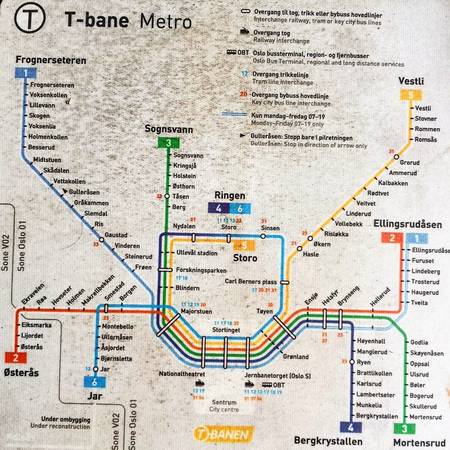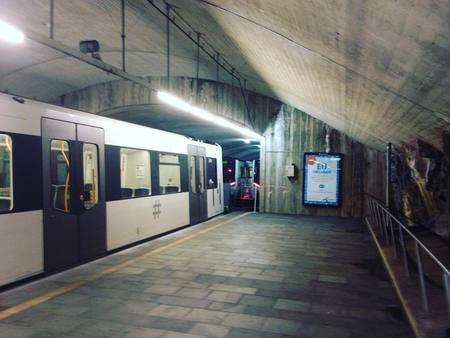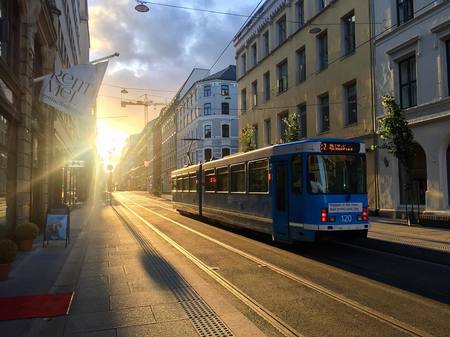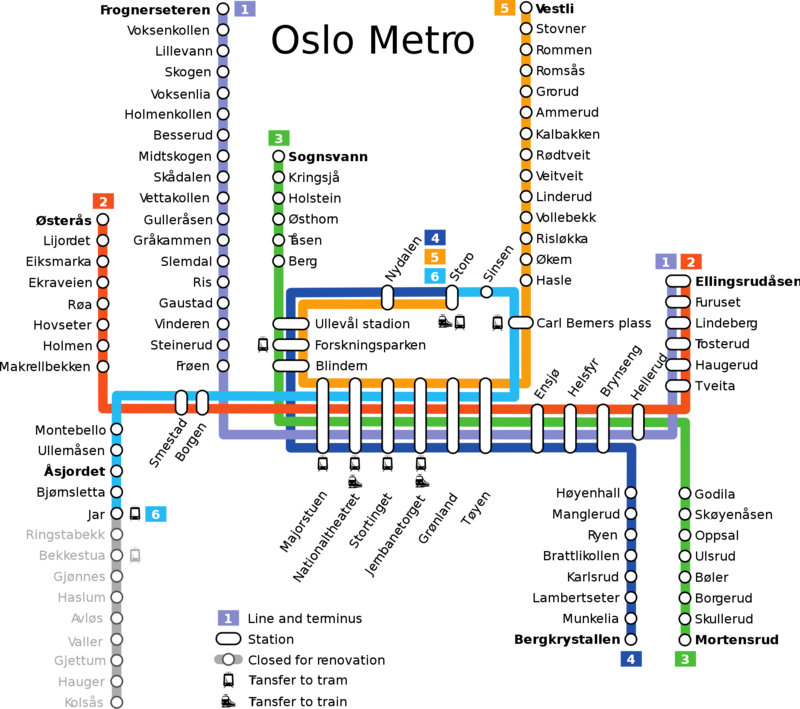The Oslo Metro was inaugurated in 1966 and is known as the T-banen. The 80 kilometers (49.7 miles) of railway is distributed along 5 commercial lines and its 101 stations provide service to 100 million riders annually.
The Oslo Metro is extremely well connected among its various routes as well as with the city’s other transportation systems such as the bus lines and trams.
Service begins between 5:30 am and 6:00 am and ends between 12:30 am and 1:00 am.
The standard ticket allows 60 minutes of travel, corresponding to the area to which it was paid. An adult ticket costs 35 NOK ($US 4.28) per zone and reaches up to 123 NOK ($US 15.04), for a maximum of 10 zones.
There is no direct connection to the airport but there is an express train route, known as the “Airport Express Train” (Flytoget). The trip takes 20 minutes.
Metros in Norway: Oslo Metro
Oslo is Norway’s capital in addition to being the most populated Nordic city, with 1.5 million citizens making up the metropolis area. It is the country’s political seat of power as well as the cultural and economic center that fuels Norway’s economy.
Oslo is a municipality as well as one of the 19 provinces that make up Norway. Additionally, it contains one of Europe’s most essential ports, from which thousands of Scandinavian products are exported every year.
Following the end of the Second World War, Oslo experienced a sustained growth throughout the second half of the twentieth century, driven by the maritime and financial sector, which led to an inevitable population growth.
Consequently, the demand for services like public transportation was underscored. With this in mind, officials began to envision the possibility of constructing a robust transportation system that would be large and fast enough to serve the community’s needs.
The Oslo Metro project, known as the “T-banen” was officially launched in 1954, although it doors didn’t officially open until 1966 with the inauguration of a tunnel that connected the city from east to west.
Since then, the network has gradually expanded, reaching a current length of 80 kilometers (49.7 miles) which is distributed along 5 commercial lines.
Oslo has a total of 101 commercial stations that altogether meet the demands of 100 million riders yearly. Thanks to the construction of a sixth line, there are additional plans to extend the network’s route.
 Oslo Metro
Oslo Metro
Lines
The Oslo Metro currently has 5 lines, with a sixth that is already under construction. The network is a total of 80 kilometers (49.70 miles). It has 101 stations divided throughout the city as it crosses the center of the Oslo metropolis from east to west. Each route can be identified by its own number and color, making it easily identifiable on underground station maps. The following lines make up the T-banen.
Line 1 (Sky Blue)
This line can be identified on system maps by the color sky blue and the number 1. It departs from Frognerseteren station, where it provides service to the Frognerseteren and Tryvann communities, and runs to Bergkrystallen station, in the Lambertseter zone. It travels to 35 stations, serving the neighborhoods of Midtstuen, Majorstuen, Nordstrand, Sentrum and Grønland, in addition to others. Line 1’s commercial stops include:
Frognerseteren ,Voksenkollen ,Lillevann ,Skogen ,Voksenlia ,Holmenkollen ,Besserud ,Midtstuen ,Skådalen ,Vettakollen ,Gulleråsen ,Gråkammen ,Slemdal ,Ris ,Gaustad ,Vinderen ,Steinerud ,Frøen ,Majorstuen ,Nationaltheatret ,Stortinget ,Jernbanetorget ,Grønland ,Tøyen ,Ensjø ,Helsfyr ,Brynseng ,Høyenhall ,Manglerud ,Ryen ,Brattlikollen ,Karlsrud ,Lambertseter ,Munkelia ,Bergkrystallen
Line 2 (Orange)
This line is identifiable on station maps by the color orange and the number 2. It runs from Østerås station, in a neighborhood by the same name, to the Ellingsrudåsen stop, connecting to the Ellingsrud and Alna communities. It provides service to 26 commercial stations, passing through the neighborhoods of Eiksmarka, Makrellbekken, Borgen, Vika, Helsfyr, along with various others. This line serves the following stations:
Østerås, Lijordet, Eiksmarka, Ekraveien, Røa, Hovseter, Holmen, Makrellbekken, Smestad, Borgen, Majorstuen, Nationaltheatret, Stortinget, Jernbanetorget, Grønland, Tøyen, Ensjø, Helsfyr, Brynseng, Hellerud, Tveita, Haugerud, Trosterud, Lindeberg, Furuset, Ellingsrudåsen
 Ellingsrud Rudasen
Ellingsrud Rudasen
Line 3 (Lilac)
Line 3’s route is characterized by the color lilac and the number 3 on Oslo Metro station maps. Its route begins at Kolsås station, in the Bærum municipality district also named Kolsås. It ends at the terminal station, Mortensrud. Located in a neighborhood, also named Mortensrud, is part of the Søndre Nordstrand district. It travels to 33 stations, passing through the communities of Haslum, Jar, Smestad, Sentrum, Tøyen, Godlia, in addition to many others. The metro stops served by Line 3 include:
Kolsås, Hauger, Gjettum, Avløs, Haslum, Gjønnes, Bekkestua, Ringstabekk, Jar, Bjørnsletta, Åsjordet, Ullernåsen, Montebello, Smestad, Borgen, Majorstuen, Nationaltheatret, Stortinget, Jernbanetorget, Grønland, Tøyen, Ensjø, Helsfyr, Brynseng, Hellerud, Godlia, Skøyenåsen, Oppsal, Ulsrud, Bøler, Bogerud, Skullerud, Mortensrud
Line 4 (Blue)
This line is distinguished on station maps by the color, dark blue as well as the number 4. Its route begins in the Stovner district in Vestli Station in a neighborhood sharing the station’s name. It travels to communities such as Grorud, Kalbakken, Linderud, Økern and Nydalen neighborhoods before reaching its final stop at Bergkrystallen station in the suburb of Lambertseter. The stations served by this line include:
Vestli , Stovner, Rommen, Romsås, Grorud, Ammerud, Kalbakken, Rødtvet, Veitvet, Linderud, Vollebekk, Risløkka, Økern, Løren, Sinsen, Storo, Nydalen, Ullevål stadion, Forskningsparken, Blindern, Majorstuen, Nationaltheatret, Stortinget, Jernbanetorget, Grønland, Tøyen, Ensjø, Helsfyr, Brynseng, Høyenhall, Manglerud, Ryen, Brattlikollen, Karlsrud, Lambertseter, Munkelia, Bergkrystallen
Line 5 (Green)
This line is number 5 on system maps and the unique color to distinguish this route from the others is green. Its route begins at Sognsvann station located in the Kringsjå neighborhood in the district Nordre Aker, and it runs to the Vestli terminal, in the Stovner district. This line travels to 33 stations, passing through the neighborhoods of Nordberg, Sinsenkrysset, Majorstuen, Jernbanetorget and Risløkka, in addition to others. The stops include:
Sognsvann, Kringsjå, Holstein, Østhorn, Tåsen, Berg, Blindern, Majorstuen, Nationaltheatret, Stortinget, Jernbanetorget, Grønland, Tøyen, Carl Bernersplass, Sinsen, Storo, Nydalen, Ullevål stadion, Forskningsparen, Hasle, Økern, Risløkka, Vollebekk, Linderud, Veitvet, Rødtvet, Kalbakken, Ammerud, Grorud, Romsås, Rommen, Stovner, Vestli
Connections
Oslo Metro is well connected along its various routes and to other transportation systems, like the bus and tram. The most relevant stations will briefly be included here to outline clear stops in which riders can make transfers.
 Sentrum
Sentrum
- Ammerud Station: This station connects Lines 4 and 5 and provides access to bus routes 62, 31, 301, 311 and 363.
- Brynseng Station: This station connects Lines 1, 2, 3 and 4 and provides access to bus routes 3B, 23 and 24.
- Forskningsparken Station: This station connects Lines 4 and 5 and provides access to tram routes 17 and 18.
- Grønland Station: This station joins Lines 1, 2, 3, 4 and 5 and provides access to bus routes 34, 37 and 74. It also connects to tram routes 18 and 19 and the Oslo Bus Terminal.
- Grorud Station: This station joins Lines 4 and 5 and connects to bus routes 31, 62, 63, 66, 68 and 79.
- Helsfyr Station: This station joins Lines 1, 2, 3 and 4 and provides access to bus routes 3B, 21, 28, 37, 66, 68, 77, 76X, 102, 103, 104, 107, 108, 313, 331, 332, 334, 336, 339, 352, 401, 411, 412, 415, 417, 418, 419, 421, 422, 431, 476, 482, 486, 492, 499, N2, N3, N4, N20, 344, TE2 and TE15.
- Høyenhall Station: This station connects Lines 1 and 4 and provides access to bus route 23.
- Jernbanetorget Station: This station connects lines 1, 2, 3, 4 and 5 and provides access to bus routes 30, 31, 34, 37, 54, 60 and 70. It additionally connects to tram routes 11, 12, 13, 17, 18 and 19 and to Oslo Central Station (the train station).
- Kalbakken Station: This station connects Lines 4 and 5 and provides access to bus routes 31, 301 and 321.
- Lambertseter Station: This station connects Lines 1 and 4 and provides access to bus routes 74, 75 and 79.
- Linderud Station: It connects Lines 4 and 5 and provides access to bus routes 59 and 60.
- Majorstuen Station: This station connects Lines 1, 2, 3, 4 and 5 provides access to bus routes 20, 22, 25, 28, 45, 46 and 156. It also connects to tram lines 11, 12 and 19.
- Manglerud Station: This station connects Lines 1 and 4 and provides access to bus routes 23 and F4.
- Nationaltheatret Station: This station connects Lines 1, 2, 3, 4 and 5 and provides access to bus routes 30, 31, 32, 70, 82 and 83 as well as to tram routes 13 and 19.
- Nydalen Station: This station joins Lines 4 and 5 and provides access to bus routes 30, 37, 51, 56, 56B and 58
- Økern Station: This station connects Lines 4 and 5 and provides access to bus routes 23, 24, 60, 67, 313, 345, 435, F3 and TE2.
- Rødtvet Station: This station connects Lines 4 and 5 and provides access to bus routes 25, 31, 33, 301 and 321.
- Rommen Station: This station connects Lines 4 and 5 and provides access to bus routes 361 and 363.
- Ryen Station: This station connects Lines 1 and 4 and provides access to bus routes 23, 70, 73, 501, 71E and F4.
- Sinsen Station: This station connects Lines 4 and 5 and provides access to bus routes 23, 24, 31, 33, 58, 301, 302, 321 and 363. It also connects to tram route 17.
- Smestad Station: This station connects Lines 2 and 3 and provides access to bus routes 6B, 23, 24, 42, 43, 45 and 202.
- Storo Station: This station connects Lines 4 and 5 and provides access to bus routes 23, 24, 56, 56B and F3 and to tram routes 11, 12 and 13.
- Stortinget Station: This station connects lines 1, 2, 3, 4 and 5 and provides access to tram routes 11, 17 and 18.
- Stovner Station: This station joins Lines 4 and 5 and provides access to bus routes 64A, 64B, 65, 120 and N5
- Tøyen Station: This station connects Lines 1, 2, 3, 4 and 5 and provides access to bus routes 20 and 60.
- Ullevål Stadion Station: This station connects Lines 4 and 5 and provides access to bus routes 22, 23, 24, 25 and F3
Schedule
Oslo Metro offers riders a very convenient daily schedule. Trains begin service between 5:30 am and 6:00 am, depending on where the vehicle originates. If they are departing from one of the far ends of any of the 5 lines – upon arriving at 5:30 am, it can take around 30 minutes to reach the route’s more central stations.
Service ends between 12:30 am and 1:00 am, also depending on the time it takes for a train to travel from a terminal station to the more central stops. However, throughout the day, the vehicles reach the platforms every 10-15 minutes.
During peak hours the frequency increases and the passenger’s wait time for each train is reduced to every 5-9 minutes. In contrast, the wait time lengthens to every 30 minutes after 11:00 pm.
Fees
The calculation for Oslo Metro fees are based on the number of zones through which a passenger travels. There are 10 zones in all which are outlined and numbered on the city map found on the system’s webpage.
However, the payment forms don’t vary much from the other similar transportation methods. Riders can choose a physical travel ticket, a reusable card or an electronic card, that is chargeable by cell phone. Included below are the prices and plans:
Single ticket
This ticket allows passengers to travel throughout the zones for 60 minutes, with a price that varies according to the zones selected. The price is additionally based on the rider’s category, for example, it the rider is a student, a child, an adult or elderly.
1 Zone
- Adults: 35 NOK, 4.28 USD.
- Children: 18 NOK, 2.20 USD.
- Students: 35 NOK, 4.28 USD.
- Seniors: 18 NOK, 2.20 USD.
- Military: 18 NOK, 2.20 USD.
2 Zones
- Adults: 57 NOK, 6.97 USD.
- Children: 29 NOK, 3.55 USD.
- Students: 57 NOK, 6,97 USD.
- Seniors: 29 NOK, 3.55 USD.
- Military: 29 NOK, 3.55 USD.
3 Zones
- Adults: 79 NOK, 9.66 USD.
- Children: 40 NOK, 4.89 USD.
- Students: 79 NOK, 9,66 USD.
- Seniors: 40 NOK, 4.89 USD.
- Military: 40 NOK, 4.89 USD.
4 Zones
- Adults: 101 NOK, 12.35 USD.
- Children: 51 NOK, 6.24 USD.
- Students: 101 NOK, 12.35 USD.
- Seniors: 51 NOK, 6.24 USD.
- Military: 51 NOK, 6.24 USD.
All zones
- Adults: 123 NOK, 15.04 USD.
- Children: 62 NOK, 7.58 USD.
- Students: 123 NOK, 15.04 USD.
- Seniors: 62 NOK, 7.58 USD.
- Military: 62 NOK, 7.58 USD.
24-hour ticket
This option offers riders 24-hour travel on the Oslo Metro. It may also be used on trams and buses, depending on the selected zones.
1 Zona
- Adults: 105 NOK, 12.84 USD.
- Children: 53 NOK, 6.48 USD.
- Students: 105 NOK, 12.84 USD.
- Seniors: 53 NOK, 6.48 USD.
- Military: 53 NOK, 6.48 USD.
2 Zones
- Adults: 171 NOK, 20.91 USD.
- Children: 86 NOK, 10.52 USD.
- Students: 171 NOK, 20,91 USD.
- Seniors: 86 NOK, 10.52 USD.
- Military: 86 NOK, 10.52 USD.
All zones
- Adults: 237 NOK, 28.98 USD.
- Children: 119 NOK, 14.55 USD.
- Students: 237 NOK, 28.98 USD.
- Seniors: 119 NOK, 14.55 USD.
- Military: 119 NOK, 14.55 USD.
7-day tickets
Selecting this option allows passengers the chance to travel on the metro for 7 consecutive days. It can also be used on trams and bus routes.
1 Zone
- Adults: 249 NOK, 30.45 USD.
- Children: 125 NOK, 15.29 USD.
- Students: 249 NOK, 30.45 USD.
- Seniors: 125 NOK, 15.29 USD.
- Military: 125 NOK, 15.29 USD.
2 Zones
- Adults: 457 NOK, 55.88 USD.
- Children: 229 NOK, 28.00 USD.
- Students: 457 NOK, 55.88 USD.
- Seniors: 229 NOK, 28.00 USD.
- Military: 229 NOK, 28.00 USD.
All zones
- Adults: 665 NOK, 81.32 USD.
- Children: 333 NOK, 40.72 USD.
- Students: 665 NOK, 81.32 USD.
- Seniors: 333 NOK, 40.72 USD.
- Military: 333 NOK, 40.72 USD.
30-day ticket
This is a 30-day metro ticket that riders can also use on the city’s tram and bus lines.
1 Zone
- Adult: 736 NOK, 90.00 USD.
- Children: 368 NOK, 45.00 USD.
- Student: 442 NOK, 54.05 USD.
- Seniors: 368 NOK, 45.00 USD.
- Military: 368 NOK, 45.00 USD.
2 Zones
- Adults: 1,305 NOK, 159.58 USD.
- Chilren: 468 NOK, 57.23 USD.
- Students: 783 NOK, 95.75 USD.
- Seniors: 468 NOK, 57.23 USD.
- Military: 468 NOK, 57.23 USD.
All zones
- Adults: 1,874 NOK, 229.15 USD.
- Children: 568 NOK, 69.46 USD.
- Students: 1,124 NOK, 137.44 USD.
- Seniors: 568 NOK, 69.46 USD.
- Military: 568 NOK, 69.46 USD.
365-day ticket
This option allows riders to enjoy one year of service on Oslo’s metro system, and can also be used on the trams and bus lines.
1 Zone
- Adults: 7,360 NOK, 899.98 USD.
- Seniors: 3,680 NOK, 449.99 USD.
2 Zones
- Adults: 13.050 NOK, 1,595.75 USD.
- Seniors: 6,525 NOK, 797.88 USD.
All zones
- Adults: 18,740 NOK, 2,291.53 USD.
- Seniors: 9,370 NOK, 1,145.76 USD.
Regulations
In an effort to optimize service, the Oslo Metro administration has laid out a set of regulations and restrictions that will result in denied station access for any riders who do not follow them.
- Pedestrian traffic is prohibited on railways and train crossings as these places are not intended for passengers.
- Lying on the floor in Oslo Metro train facilities or on trains is prohibited.
- One may not enter the underground stations on skates or a skateboard.
- Baggage should not interfere with the comfort of other passengers. Large bulky packages are not permitted on trains.
- Pets must be in appropriate carrying cases or on a leash during travel. Animals may not be placed on seats, on the floor or in one’s lap.
- Flammable materials, explosives and firearms are prohibited. Also prohibited are sharp objects, odorous items, excessively large items and transporting any object that poses a dangerous threat to other riders.
- Under no circumstances will hostile behavior, posing the threat of physical harm to other passengers, be tolerated.
- Smoking nor alcohol consumption is permitted in Oslo Metro facilities.
- Riders must not hinder the opening of closing of the doors.
- One must not misuse emergency devices in stations or on trains.
- It is pertinent to always keep one’s travel ticket on hand in the event that security personnel could request to review it at any moment.
- Propaganda may not be distributed within metro facilities without prior authorization from system officials.
- When traveling with multimedia devices, it is essential that one use headphones so as to not disturb other passengers.
Connection to the airport
Transportation from the city center to the Oslo-Gardermoen Airport is extremely simple with the proper transportation methods. The air terminal does not have a direct connection to the Oslo Metro, but there is an express train route, which gets riders there in just about 20 minutes.
This service is called the “Airport Express Train” (Flytoget). It is a high-speed train – that reaches up to 210 kilometers per hour (130.5 miles per hour) It departs from Oslo’s Central Station (Oslo S), towards the airport, with just about one stop on average, which still does not delay the 20 minute arrival time for passengers. To reach Central Station by metro, one should get off at “Jernbanetorget, which is accessible by 5 of the system’s lines. Upon reaching the surface level of “Jernbanetorget”, one will find Oslo S right next to it.
After locating Central Station, one must locate the “Flytoget” ticket window. A physical ticket can be purchased here for 180 NOK ($US 22.01) or an electronic one can be purchased through the mobile app.
Oslo T-Bane map
- Also Known As: T-Bane
- Passengers/Day 268000
- Fares: 2.67
- 24h operation: No
- Air Conditioning: No
- Walk between platforms: Yes
- Driverless trains: No
- Screen Doors Platforms: No
- Operator: Oslo T-banedrift
- 32 NOK
- Oslo Metro Official Website
Help us
If you consider that the information we provide is wrong, not accurated, outdated, translation contains errors, and you would like to help us to improve the file...you can contact us here.
Feel free to contact us if you dont find the system you're looking for and we'll add it as soon as we can!
Thank you very much!







